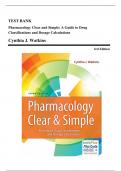Exam (elaborations)
Test Bank - Pharmacology Clear and Simple: A Guide to Drug Classifications and Dosage Calculations, 3rd Edition (Watkins, 2019), Chapter 1-21 | All Chapters
- Course
- Institution
- Book
Test Bank - Pharmacology Clear and Simple: A Guide to Drug Classifications and Dosage Calculations, 3rd Edition (Watkins, 2019), Chapter 1-21 | All Chapters
[Show more]



